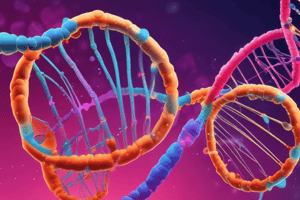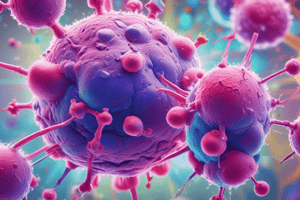Podcast
Questions and Answers
What characterizes paracrine signaling?
What characterizes paracrine signaling?
- It binds to receptors on the same cell.
- It acts on distant target cells.
- It releases signals into extracellular fluid acting locally. (correct)
- It transmits signals electrically along a nerve cell.
Which type of signaling requires direct contact between cells?
Which type of signaling requires direct contact between cells?
- Endocrine signaling
- Paracrine signaling
- Contact-dependent signaling (correct)
- Neuronal signaling
What type of cell death is characterized by an organized and controlled cellular process, usually beneficial to the organism?
What type of cell death is characterized by an organized and controlled cellular process, usually beneficial to the organism?
- Ischemia
- Infarct
- Necrosis
- Apoptosis (correct)
What is the function of mitogens?
What is the function of mitogens?
Which of the following is NOT a feature of reversible injury?
Which of the following is NOT a feature of reversible injury?
Which phase of the cell cycle is primarily concerned with DNA replication?
Which phase of the cell cycle is primarily concerned with DNA replication?
Which of the following describes the cellular injury that is not reversible?
Which of the following describes the cellular injury that is not reversible?
What can lead to decreased oxidative phosphorylation?
What can lead to decreased oxidative phosphorylation?
What term refers to the shrinkage and condensation of the nucleus during apoptosis?
What term refers to the shrinkage and condensation of the nucleus during apoptosis?
What is a primary factor that differentiates reversible injury from irreversible injury?
What is a primary factor that differentiates reversible injury from irreversible injury?
Which statement about growth factors is accurate?
Which statement about growth factors is accurate?
Which type of necrosis is characterized by the death of adipose tissue due to enzymatic digestion?
Which type of necrosis is characterized by the death of adipose tissue due to enzymatic digestion?
Which of the following is NOT a function of signal molecules in cell signaling?
Which of the following is NOT a function of signal molecules in cell signaling?
What indicates irreversible cell injury?
What indicates irreversible cell injury?
In terms of morphology, what is a common microscopic feature of necrosis?
In terms of morphology, what is a common microscopic feature of necrosis?
Which cellular phase acts as a checkpoint for the cell to decide whether to proceed to DNA replication or not?
Which cellular phase acts as a checkpoint for the cell to decide whether to proceed to DNA replication or not?
What characterizes irreversible cell injury?
What characterizes irreversible cell injury?
Which type of cell death is characterized by a lack of inflammatory reaction?
Which type of cell death is characterized by a lack of inflammatory reaction?
Which morphological change is NOT associated with necrosis?
Which morphological change is NOT associated with necrosis?
What is a key feature of coagulative necrosis?
What is a key feature of coagulative necrosis?
In which condition is liquefactive necrosis commonly seen?
In which condition is liquefactive necrosis commonly seen?
Which type of necrosis involves multiple tissue planes?
Which type of necrosis involves multiple tissue planes?
Which of the following describes a significant indicator of necrosis?
Which of the following describes a significant indicator of necrosis?
What is a common outcome of necrosis?
What is a common outcome of necrosis?
What type of necrosis is a localized area of coagulative necrosis called?
What type of necrosis is a localized area of coagulative necrosis called?
Which morphological change is particularly characteristic of necrotic cells?
Which morphological change is particularly characteristic of necrotic cells?
What is the characteristic appearance of caseous necrosis?
What is the characteristic appearance of caseous necrosis?
In which condition is fibrinoid necrosis most commonly observed?
In which condition is fibrinoid necrosis most commonly observed?
What does fat necrosis primarily result from?
What does fat necrosis primarily result from?
Which condition does NOT contribute to cellular injury due to oxygen deprivation?
Which condition does NOT contribute to cellular injury due to oxygen deprivation?
Which mechanism is a key factor in cellular injury?
Which mechanism is a key factor in cellular injury?
What is a defining characteristic of apoptosis?
What is a defining characteristic of apoptosis?
In which apoptotic pathway is the intrinsic pathway involved?
In which apoptotic pathway is the intrinsic pathway involved?
Which of the following is a common feature of necrosis?
Which of the following is a common feature of necrosis?
What is primarily damaged during cellular injury?
What is primarily damaged during cellular injury?
Fat necrosis leads to the formation of which structure in the affected area?
Fat necrosis leads to the formation of which structure in the affected area?
Flashcards
Cell Growth/Proliferation
Cell Growth/Proliferation
The process where cells increase in number and size.
Necrosis
Necrosis
A type of cell death characterized by uncontrolled cell breakdown.
Apoptosis
Apoptosis
A type of programmed cell death that is essential for normal development and tissue homeostasis.
Cell Cycle
Cell Cycle
Signup and view all the flashcards
Cell Cycle Regulatory System
Cell Cycle Regulatory System
Signup and view all the flashcards
Ischemia
Ischemia
Signup and view all the flashcards
Infarct
Infarct
Signup and view all the flashcards
Cell Signaling
Cell Signaling
Signup and view all the flashcards
Paracrine Signaling
Paracrine Signaling
Signup and view all the flashcards
Neuronal Signaling
Neuronal Signaling
Signup and view all the flashcards
Contact-Dependent Signaling
Contact-Dependent Signaling
Signup and view all the flashcards
Survival Factors
Survival Factors
Signup and view all the flashcards
Mitogens
Mitogens
Signup and view all the flashcards
Growth Factors
Growth Factors
Signup and view all the flashcards
Reversible Cell Injury
Reversible Cell Injury
Signup and view all the flashcards
Irreversible Cell Injury
Irreversible Cell Injury
Signup and view all the flashcards
Mitochondrial Dysfunction
Mitochondrial Dysfunction
Signup and view all the flashcards
Membrane Integrity
Membrane Integrity
Signup and view all the flashcards
Karyolysis
Karyolysis
Signup and view all the flashcards
Pyknosis
Pyknosis
Signup and view all the flashcards
Karyorrhexis
Karyorrhexis
Signup and view all the flashcards
Coagulative Necrosis
Coagulative Necrosis
Signup and view all the flashcards
Liquefactive Necrosis
Liquefactive Necrosis
Signup and view all the flashcards
Caseous Necrosis
Caseous Necrosis
Signup and view all the flashcards
Fibrinoid Necrosis
Fibrinoid Necrosis
Signup and view all the flashcards
Fat Necrosis
Fat Necrosis
Signup and view all the flashcards
Hypoxia
Hypoxia
Signup and view all the flashcards
What are the key cellular components most frequently damaged in cell injury?
What are the key cellular components most frequently damaged in cell injury?
Signup and view all the flashcards
Intrinsic (Mitochondrial) Pathway
Intrinsic (Mitochondrial) Pathway
Signup and view all the flashcards
Extrinsic (Death Receptor Initiated) Pathway
Extrinsic (Death Receptor Initiated) Pathway
Signup and view all the flashcards
Morphologic Features of Apoptosis
Morphologic Features of Apoptosis
Signup and view all the flashcards
Study Notes
Cell Growth/Proliferation, Necrosis/Apoptosis, Tissue Injury
- The stability of a structure is directly related to the security of its foundation (Blake Higginbotham quote)
- The lecture outlines cell growth/proliferation, cell injury/death (reversible/irreversible), cell injury mechanisms, and morphological features of cell death (necrosis/apoptosis).
Lecture Outline
- Cell Growth/Proliferation
- Cell Injury/Death
- Reversible injury
- Irreversible injury
- Mechanisms of cell injury
- Mechanisms and morphological features of cell death
- Necrosis
- Apoptosis
Lecture Objectives
- Define and use relevant terms (pyknosis, karyorrhexis, karyolysis, ischemia, infarct) correctly.
- Describe the morphological and biochemical features of apoptosis.
- List examples of apoptosis in physiological and pathological conditions.
- Describe the morphological and biochemical features of necrosis.
- Compare necrosis and apoptosis in terms of critical features, common situations of occurrence, and mechanisms of development.
- Compare the types of necrosis (coagulative, caseous, fat, liquefactive, and gangrenous) by gross and microscopic features, common sites/tissues involved, and common causes/mechanisms
- Provide examples for each type
Cell Cycle
- The cell cycle includes the phases: M phase (mitosis), S phase (DNA replication), G1/G2 phases
- Control/regulatory systems regulate DNA replication, mitosis, and cytokinesis.
- Checkpoints occur in G1 and G2 to decide if a cell proceeds to the next phase.
Cell Growth/ Proliferation: Cellular Requirements
- Cellular requirements for growth and proliferation include nutrients and chemical signals from other cells.
- Signal molecules are either soluble proteins, proteins bound to the surface of other cells, or proteins bound to the extracellular matrix (ECM).
- Signal molecules stimulate or inhibit cellular function.
Cell Signaling
-
Endocrine: Hormones secreted into the bloodstream are distributed throughout the body.
-
Paracrine: Paracrine signals are released into the extracellular fluid and affect nearby cells.
-
Synaptic: Neuronal signals are transmitted electrically along a nerve axon; this causes neurotransmitter release to adjacent target cells
-
Contact-dependent: A cell-surface-bound signal molecule binds to a receptor protein on an adjacent cell.
Cell Growth/Proliferation: Signal Molecules Categories
- Stimulatory signal molecules are classified into three major categories:
- Survival factors: Suppress apoptosis
- Mitogens: Stimulate cell division
- Growth factors: Stimulate cell growth
Cell Injury/Cell Death - Reversible vs. Irreversible
- Cell death is the consequence of cell injury.
- Reversible vs. irreversible injury
- Stress
- Injurious stimulus
- Adaptive response
- Ability/Inability to adapt
- Reversible cell injury vs. cell death (e.g., necrosis, apoptosis)
Reversible Cell Injury
-
Hallmarks: Decreased oxidative phosphorylation (ATP formation), Na+/K+ ATPase pump abnormalities, membrane alterations, changes in intracellular ion concentration, cellular swelling, alterations in intracellular organelles, defects in protein synthesis, cytoskeletal damage, DNA damage.
-
Light microscopic features: Cellular swelling due to energy-dependent ion pump failure, fatty change, abnormal processing of fatty acids.
-
Ultrastructural features: Plasma membrane blebbing, loss of microvilli, mitochondrial swelling, dilation of ER, detachment of polysomes, myelin figures, nuclear alterations.
Irreversible Cell Injury
- Cell can no longer adapt, resulting in cell death.
- Characterized by severe mitochondrial damage and loss of membrane integrity.
Cell Injury/Cell Death: Two Types
- Necrosis:
- Unregulated cell death, leakage of lysosomal enzymes into cytoplasm, inflammatory reaction, and a pathological process.
- Apoptosis:
- Programmed cell death, nuclear dissolution, no inflammatory reaction, and serves many normal cellular functions.
Necrosis: Morphologic Changes
- Increased eosinophilia, glassy appearance, vacuolated appearance, myelin figures, dilated mitochondria with amorphous densities
- Nuclear changes:
- Karyolysis (fading/loss of basophilia)
- Pyknosis (nuclear shrinking; increased basophilia)
- Karyorrhexis (nuclear fragmentation)
Patterns of Tissue Necrosis
- Coagulative necrosis: Preservation of tissue architecture for a few days; blocked proteolysis of dead cells. Seen in ischemia due to vessel obstruction (e.g., infarcts).
- Liquefactive necrosis: Tissue converted to a liquid viscous mass; common in bacterial infections (abscesses) and brain infarcts.
- Caseous necrosis: Area of necrosis appears white, friable, and cheese-like; a characteristic feature of tuberculous infection.
- Fibrinoid necrosis: Deposition of immune complexes, blood vessels, pink amorphous area of necrosis.
- Fat necrosis: Focal area of fat destruction, common in acute pancreatitis, formation of calcium soaps.
- Gangrenous necrosis: Often coagulative, involving multiple tissue planes and necrosis of a limb due to blood supply loss.
Cell Injury: Causes
- Oxygen deprivation: Hypoxia (deficiency of oxygen), ischemia (reduced blood flow), inadequate blood oxygenation, decreased oxygen-carrying capacity, decreased blood volume.
- Physical agents: Mechanical trauma, extremes of temperature (burns, deep cold), radiation, electric shock.
- Chemical agents and drugs: Normal ions in high concentrations, poisons, pollutants, insecticides, herbicides, alcohol, therapeutic drugs.
- Infectious agents
- Immunologic reactions: Autoimmune reactions, reactions to microbes.
- Genetic defects: Defects in functional proteins, accumulation of misfolded proteins, DNA damage
- Nutritional imbalances: Protein-calorie deficiencies, vitamin deficiencies, nutritional excess
Mechanisms of Cell Injury
- Cellular response depends on injury type, duration, and severity.
- Consequences depend on injured cell type, state, and adaptability
- Key cellular components frequently damaged include mitochondria, cell membranes, proteins synthesis/packaging, and DNA
- Key mechanisms include decrease in ATP, mitochondrial damage, loss of calcium homeostasis, oxygen-derived free radicals (oxidative stress), defects in membrane permeability, and abnormal proteins.
Studying That Suits You
Use AI to generate personalized quizzes and flashcards to suit your learning preferences.



